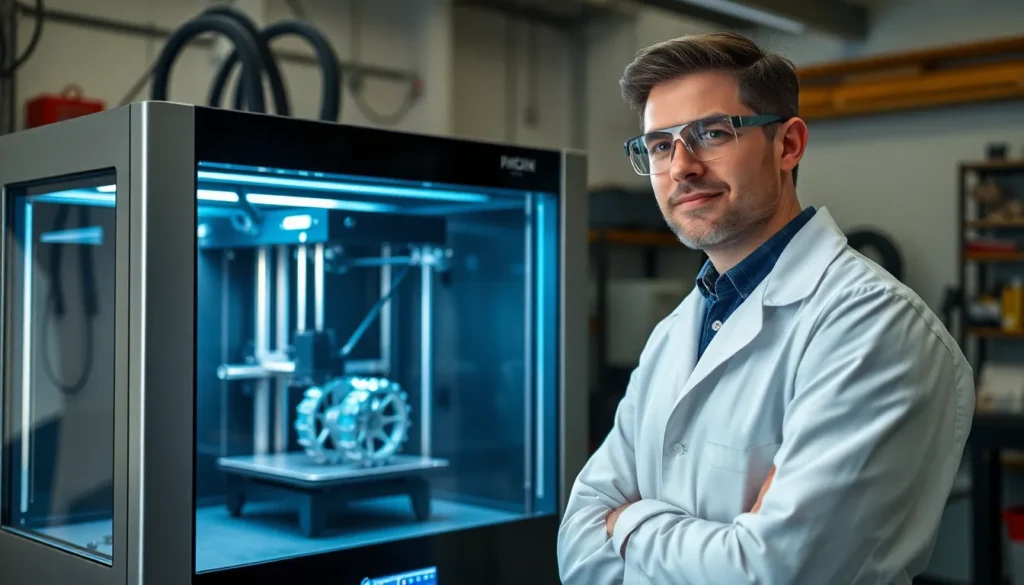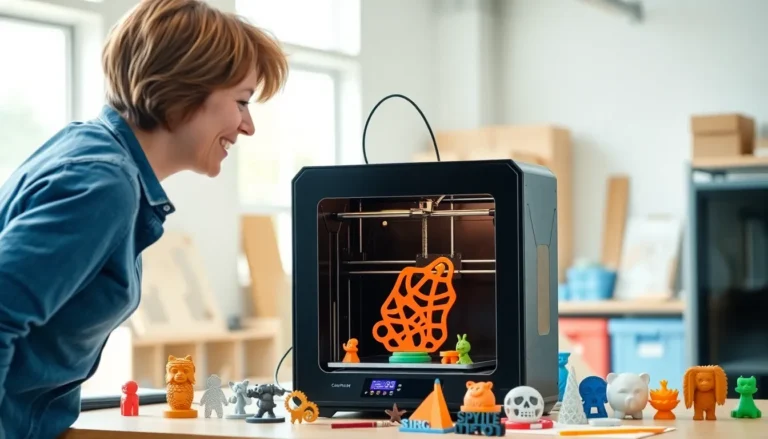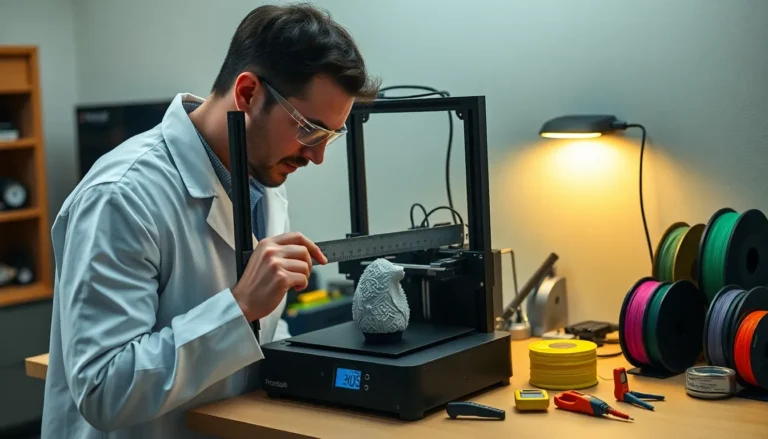In a world where everything seems to be made of plastic, carbon fiber 3D printing swoops in like a superhero in a spandex suit, ready to save the day. This innovative technology combines the lightweight, high-strength properties of carbon fiber with the creative freedom of 3D printing. Imagine crafting parts that are not only durable but also look like they belong on a spaceship. Who wouldn’t want that?
Table of Contents
ToggleOverview of Carbon Fiber 3D Printing
Carbon fiber 3D printing integrates advanced materials with modern fabrication techniques. This process creates lightweight yet high-strength components that outperform traditional materials. Companies increasingly adopt carbon fiber for applications in aerospace, automotive, and sporting goods due to its superior mechanical properties.
The method involves mixing carbon fiber strands with thermoplastic filaments. This combination results in a material that takes advantage of both flexibility and rigidity. Printed parts exhibit excellent stiffness and impact resistance, making them ideal for demanding environments.
Using carbon fiber in 3D printing allows for complex geometries that traditional manufacturing struggles to achieve. It supports intricate designs while maintaining structural integrity. As a result, engineers can optimize parts for better performance and efficiency.
Cost considerations influence the popularity of this technology. While initial investments in carbon fiber printers may be higher, the durability and lightweight nature of the resulting parts often lead to reduced operational costs. Over time, savings on materials and enhanced product longevity yield significant financial benefits.
The versatility of carbon fiber 3D printing opens doors to innovative designs. Customization options cater to specific industry requirements, offering tailored solutions that enhance performance. As the technology evolves, more industries explore its potential to reduce weight and improve functionality.
Carbon fiber 3D printing stands out due to its unique combination of materials and technology. Usage across various sectors continues to grow, driven by its capability to produce high-strength, lightweight components efficiently.
Advantages of Carbon Fiber 3D Printing

Carbon fiber 3D printing presents significant benefits for various industries. The combination of strength, durability, and lightweight properties makes this technology appealing for manufacturing applications.
Strength and Durability
Strength and durability define carbon fiber materials, making them ideal for demanding applications. Carbon fiber’s tensile strength can reach over 5,800 MPa, significantly outperforming many metals. Parts produced through carbon fiber 3D printing exhibit excellent resistance to fatigue and impact, ensuring long-lasting performance. In aerospace and automotive sectors, components withstand harsh environments, enhancing safety and reliability. Its ability to resist deformation under stress allows engineers to design parts that maintain structural integrity in critical situations. This remarkable performance attributes lead many companies to switch from traditional materials to carbon fiber, seeking enhanced durability for their products.
Lightweight Properties
Lightweight properties further distinguish carbon fiber 3D printing from conventional manufacturing methods. Weighing about one-quarter of aluminum, carbon fiber minimizes mass while maintaining strength. The low density allows for more efficient energy consumption, particularly in transportation applications, where weight reduction improves fuel efficiency. With structural optimization, engineers create complex geometries without sacrificing performance. Various sectors benefit from reduced component weight, allowing for innovative design opportunities. The combination of lightweight and strength enables manufacturers to push the boundaries of product development, achieving superior functionality in competitive markets.
Applications of Carbon Fiber 3D Printing
Carbon fiber 3D printing transforms various industries by offering lightweight and strong components. Its specific advantages enhance performance across numerous applications.
Aerospace Industry
Aerospace relies heavily on carbon fiber 3D printing for producing lightweight parts. Reducing weight in aircraft systems significantly improves fuel efficiency, which is crucial given the rising fuel costs. Engineers create complex geometries that optimize airflow, providing enhanced aerodynamic performance. Additionally, components such as brackets, ducting, and frames exhibit superior strength-to-weight ratios, essential for safety and compliance. Companies in this sector utilize carbon fiber parts for prototypes and final products, streamlining production processes while minimizing waste.
Automotive Industry
In the automotive sector, carbon fiber 3D printing plays a vital role in manufacturing high-performance components. Lightweight structures contribute directly to better speed and agility, enabling manufacturers to produce more efficient vehicles. Customization options allow automotive engineers to tailor parts specifically to vehicle designs. Applications include interior components, structural elements, and even body panels, showcasing the versatility of this technology. By adopting carbon fiber printing, automakers achieve cost reductions in production and enhanced overall vehicle performance, promoting sustainability.
Medical Field
The medical field benefits from carbon fiber 3D printing by enabling the fabrication of patient-specific devices. Customized prosthetics and orthopedic implants address individual needs, improving comfort and functionality. Materials with excellent biocompatibility ensure safety for patients, while lightweight designs facilitate easier handling. Surgical instruments crafted from carbon fiber prove more durable and precise, enhancing surgical outcomes. Hospitals increasingly adopt these innovations, resulting in improved care and better patient experiences through technology that adapts to unique anatomical requirements.
Challenges in Carbon Fiber 3D Printing
Carbon fiber 3D printing offers numerous advantages but also presents challenges that manufacturers face in its adoption. Understanding these challenges is essential for effective implementation.
Cost Considerations
High initial costs often deter companies from investing in carbon fiber 3D printing technology. Equipment expenses can exceed $100,000, which creates a barrier for small businesses. Material costs may also be higher compared to traditional 3D printing filaments, with carbon fiber filaments priced between $50 to $150 per kilogram. Long-term savings often counterbalance these initial investments, as durability leads to reduced operational costs. Additionally, specialized training programs for staff may incur extra costs, impacting the overall budget.
Technical Limitations
Carbon fiber 3D printing has certain technical limitations that can affect production. Not all printers accommodate carbon fiber, limiting options to high-end models. Print speeds can be slower compared to standard plastic filaments due to the material’s abrasive nature. Post-processing requires more effort, as parts often need sanding or finishing to achieve desired surface quality. Furthermore, achieving optimal layer adhesion can pose challenges, particularly in complex designs. Overall, addressing these technical hurdles is crucial for maximizing the advantages of carbon fiber materials.
Future Trends in Carbon Fiber 3D Printing
Emerging trends in carbon fiber 3D printing point toward increased adoption across multiple industries. Enhanced materials continue to play a significant role in its advancement. Researchers focus on developing hybrid filaments that integrate other fibers, improving performance and functionality.
Automation is also becoming integral to carbon fiber 3D printing. Innovations in automated systems will streamline production, reduce human error, and lower labor costs. This progress positions manufacturers to meet rising demand efficiently.
Sustainability remains a key factor influencing future developments. Efforts to create recyclable carbon fiber materials will likely gain traction as companies prioritize eco-friendly practices. Availability of biodegradable filaments may further support sustainable manufacturing.
Integration of artificial intelligence into carbon fiber 3D printing processes will optimize operations. AI systems can predict failures, enhance design processes, and monitor production quality. This capability allows businesses to maximize output and reduce waste.
Customization will become even more critical in product design. As carbon fiber printing technology advances, manufacturers can offer tailored solutions, meeting specific client needs across sectors like aerospace and automotive. Greater flexibility will enable engineers to craft unique components without traditional constraints.
Collaboration between industry leaders and research institutions can catalyze innovation. Partnerships facilitate knowledge sharing that drives technological breakthroughs, ensuring carbon fiber 3D printing remains competitive. Expanding educational initiatives around this technology should also empower the next generation of engineers.
Continued exploration of applications will open new markets and possibilities. From aerospace to sporting goods, growth opportunities abound. As carbon fiber 3D printing evolves, its impact on manufacturing practices is poised to shift dramatically.
Carbon fiber 3D printing is reshaping the landscape of manufacturing by combining strength and lightweight design. Its ability to produce complex geometries and durable components makes it a game-changer for industries like aerospace and automotive. While challenges exist in terms of costs and technical limitations, the long-term benefits and potential for innovation far outweigh these hurdles.
As technology advances and more companies embrace this method, the future looks promising. The integration of automation and sustainable practices will further enhance its appeal. With ongoing research and collaboration, carbon fiber 3D printing is set to revolutionize product development and drive efficiency across various sectors.





